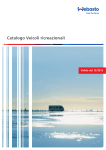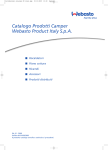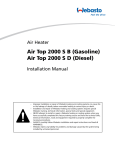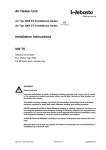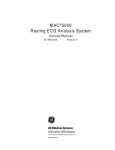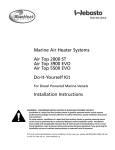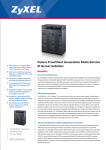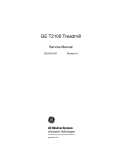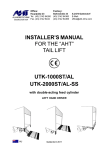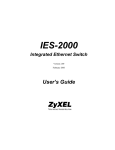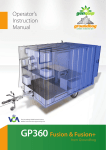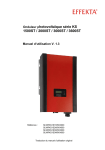Download Webastoto DWB 2016 Operating instructions
Transcript
Installation Instructions Marine heating systems Air heating: Air Top 2000ST® Air Top 3500® Air Top 5000® HL 90® Water heating: Thermo Top C® Thermo 90 ST® DBW 2010, 2016® Thermo 230, 300, 350® ® Marine heating system Installation Instructions Table of contents 1 2 3 4 5 6 7 8 9 10 11 12 13 Safety instructions ........................................................................................3 General ...........................................................................................................4 Heating system selection .............................................................................5 Installation of the heating system................................................................6 Exhaust...........................................................................................................9 Combustion air supply................................................................................12 Fuel supply...................................................................................................13 Electrics........................................................................................................18 Air heaters....................................................................................................19 Water heaters...............................................................................................30 Acceptance and Commissioning ...............................................................38 Operating instructions ................................................................................38 Maintenance and Service............................................................................39 Symbols used Specific risk of injury or fatal accidents Legal regulations and technical documentation Specific risk of fire or explosion Reference to a special technical feature Recommendations This brochure supplements the device-specific installation and operating instructions for the respective ® heating units with information that is required for installation in marine vessels. It contains important safety instructions and refers to chapters in the device-specific installation and operating instructions, which must also be observed. Read these instructions completely before operating the first time! If you have still have any questions after reading this brochure: Contact an authorized Webasto® Partner (www.webasto-marine.com) or the Webasto® Support Hotline. 2 © Webasto Global Comfort Solutions® Marine heating system Installation Instructions 1 Safety instructions Heating systems should only be installed by an authorized Webasto® Partner. If you want to install a Webasto® heater system yourself: The installation assumes that you have sufficient technical and craft knowledge and skill. Unskilled installation can endanger life! Before first use, the heating system must be checked by an authorized Webasto® Partner! DANGER This is both for your safety and for the safety of third persons. • With do-it-yourself installation: The installation is extensive and can take, depending on the boat type and size, between 8 and 40 hours. It presupposes sufficient technical and craftwork knowledge and skills, for example in boat construction, marine electrical systems, heating engineering and fuel systems. • Incorrect installation or repair of Webasto® heating systems may cause a fire or result in the emission of carbon monoxide, which can be fatal. Serious or fatal injuries can be caused as a result. • Observe carefully: applicable accident prevention regulations and workshop and work safety instructions. • Observe regional regulations! Clarify which regulations apply for the planned use of the boat. Check these! If necessary, obtain official permission. • ALWAYS obey: Installation and repair instructions. If there are any doubts, safety questions or technical questions: obtain professional support from an authorized Webasto® Partner (www.webasto-marine.com) or the Webasto® Support Hotline! • Failure to observe individual points can lead to damage to the heating system or the boat. Pay attention to all warnings! Follow the technical rules! Only use original accessories and original spare parts. Only use approved Webasto® control components! Otherwise there is a risk of malfunctions. For accessories, installation and assembly components, see the Webasto® parts catalog The example installations shown in this documentation are for information purposes only. No liability can be derived from the installation examples shown. • • • • • © Webasto Global Comfort Solutions® 3 Marine heating system Installation Instructions • WARNING! When positioning the exhaust outlet, prevent the re-entry of the exhaust gasses into the warm air system or the accommodation areas. Danger of suffocation! • WARNING! Never feed combustion air into the accommodation areas. Danger of suffocation! • WARNING! The heating system must be turned off while refueling. • WARNING! Use only fire resistant fuel lines and temperature proof thermally insulated heating air hoses. Fire risk! • WARNING! Do not blow hot air directly onto living creatures or temperature sensitive parts. 2 General Use of the heating system Solely for use on ships: • For the pre-heating and heating of ship cabins, cargo holds, personnel and crew transportation areas • on inland waters and at sea • for sailing and motor boats from approximately 8 to 28 m in length Not suitable for continuous heating of living areas, houseboats, etc. for heating and/or drying living beings Permits Existing heating system permits with a symbol on type plate: • EU type permit in accordance with directive 72/245/EWG for electromagnetic compatibility • EU type permit in accordance with directive 2001/56/EG for fuel-powered heating • CE symbol (prescribed in EU for new recreational craft from 2.5 to 24 m length ) Relevant standard for installation - Recreational craft directive 94/25/EG - ISO 8845/46 – Protection against ignition of surrounding flammable gasses - ISO 7840 – Fire-resistant fuel hoses 4 © Webasto Global Comfort Solutions® Marine heating system Installation Instructions 3 Heating system selection Criteria for heating system selection • Boat length • region where used, • Season and • Boat form Simplified graphical representation 1. Select the boat length. 2. Go horizontally to the left to the line for the region. 3. Go vertically downwards to the line for the season when used. 4. Go horizontally to the right. a) Water heater: Follow the boat type line vertically downwards in the lower triangle. b) Air heater: Follow the boat type line vertically up in the upper right triangle. More accurate capacity rating of the heat requirement: calculate approx. 150 to 200 W heating capacity per m³ of heated area. For extreme cold, calculate 250-400 W per m³. Use the upper or lower guide value according to • Operating area, • Boat hull/superstructure insulation, • Integration of a hot water boiler. Recommendations: Air heating for ships from 15 m: use two systems (better warm air distribution and controllability, less noise and power consumption). Use separate connections for electricity, exhaust gas, fuel supply, etc. © Webasto Global Comfort Solutions® 5 Marine heating system Installation Instructions 4 Installation of the heating system 4.1 Choosing the location • • • • • • Install the heating system in a dry location; protected from the ingress of sea water, excessive vibration, heat and engine exhaust gasses Suit the installation for the type of use/type of boat. Observe: all peripheral components such as maximum permitted exhaust length, on-board wall duct positions, combustion air intake, electrical wiring and cable lengths, distance from fuel tank, routing of warm air hoses, fresh air intake, etc. For data, see the equipment-specific installation instructions. Observe: Maximum ship inclination cannot lead to the ingress of sea water through the exhaust outlet. Inclination must not bring the heating system into contact with bilge water. Do not obstruct moving parts (e.g. rudder assembly) When arranging the heating system, avoid the danger of injury to persons or the risk of damage to objects as much as possible. Fire risk! The heating system can overheat. • Pay attention to maintaining a sufficient distance and sufficient ventilation for all parts. • Use only fire resistant materials. • If necessary, fit a heat shield. • Do not install in the vicinity of flammable or temperature-sensitive objects such as sails, fenders, bulkheads, paper, gas lines, fuel containers, etc. • When installing in a lockers or control cabinets; • Only with good ventilation • Prevent contact with hot parts • If necessary, create a contact barrier around the heating system DANGER • 6 Recommended locations: o not next to sleeping berths or next to the salon (because of ventilation noise) o in lockers or control cabinets, if the are well ventilated. If necessary create a contact barrier around the heating system so that the sail, fender, bulkheads, etc. do not come into contact with hot parts. o in the engine compartment of inboard diesel engines. Assuming: Hot air intake from outside, combustion air intake from outside or the engine compartment if this is well ventilated to the outside. © Webasto Global Comfort Solutions® Marine heating system Installation Instructions Heating system installation in lockers (1), control cabinets (2) or engine compartment (3). 4.2 Equipment orientation Permissible installation locations: see device-specific installation instructions. 0-90˚ 0-90˚ 0-90˚ Examples of permissible installation locations for Air Top® air heating system and Thermo 90 ST® water heating system • • • Installation locations: consider possible ship inclination. Recommended installation location: exhaust outlet downwards, heater parallel to ship’s longitudinal axis. Do not install transversely in sailing boats. Exception: if heater operation is only when moored or in motorboats then installation transverse to the longitudinal axis is also permissible. Install heater system along the longitudinal axis in sailing boats. © Webasto Global Comfort Solutions® 7 Marine heating system Installation Instructions 4.3 Heater mounting • • Securely mount the equipment (vibration, swell)! Use a mounting assembly or bracket Air heaters: use the bracket and rubber seals provided under the feet of the equipment. Securing Air Top® using the mounting bracket • • • Recommendation: flexible mountings (decoupling oscillations, noise reduction) Secure the heater unit with screws to the mounting assembly. Recommendation, if attached to the outside skin of GRP boats: Laminate a wooden plate on the inside at the mounting location to avoid having to drill through the outer skin. WARNING! When drilling into the outer skin of the ship there is a risk of drowning! Drilling under the water line can cause the ship to sink. If the boat is in the water: check the drilling location. Keep leak sealing equipment available and familiarize yourself with the possible escape routes. 8 © Webasto Global Comfort Solutions® Marine heating system Installation Instructions 5 Exhaust 5.1 Exhaust system Feed the combustion gasses out of the boat through the exhaust system. 1) Heater; 2) Combustion air intake; 3) Flexible stainless steel exhaust pipe; 4) Condensation drain; 5) Exhaust gas sound absorber; 6) Isolation; 7) Goose neck; 8) On-board duct 5.2 Exhaust outlet Outlet arrangement: • Position the exhaust outlet where as little water spray can enter as possible. Recommendation: Sail boat: in the stern transom. Motor boat: in the lateral side wall. WARNING! Do not position the exhaust outlet underneath or next to ventilation equipment, window openings or the heating air intake (risk of suffocation). • • • • at least 60 cm above the water line so that no water can enter when the boat heels. do not connect to the engine or generator exhaust line (higher pressure, damage to the heater). not in the direction of movement of the boat (higher wind pressure). not where it can be covered easily, e.g. by the fender. Wall ducts: • Choose the design and installation position: minimize rain water ingress. • Only metals ducts are permissible. Use insulating washers for thermal isolation from the walls. Use properly fitting seals (minimizing water ingress). If additional seals are needed: use heat-resistant sealant only. • Wall ducts: Not sealable; not with self-opening valves. © Webasto Global Comfort Solutions® 9 Marine heating system Installation Instructions Always assemble wall ducts with seals. 5.3 Exhaust pipe 5.3.1 Exhaust pipe Use 2-layer stainless steel flexible exhaust pipe. • Keep the exhaust pipe as short as possible (maximum exhaust pipe length: see device-specific installation instructions). • Route the exhaust pipe as straight as possible (permissible number of bends, smallest permissible curve radius: see device-specific installation instructions). • No contact with temperature-sensitive objects such as electrical cables, water pipes, plastic parts, sails or boat hull. • Minimum wall distance: ≥ 20 mm. • Minimum pipe diameters; see device-specific installation instructions. 5.3.2 Exhaust gas pipes in personnel accommodation WARNING! Avoid installing the heater and exhaust pipes in personnel accommodation if possible. (Danger of suffocation if routing is inappropriate) • • • • If unavoidable: use rigid stainless steel pipes with a wall thickness ≥ 1mm. Replace pipes with new ones after ≤ 10 years. Make the joints especially precise and gas tight. Use high temperature resistant sealing compound. 5.4 Exhaust pipe connections • • • When routing the exhaust pipes, pay attention: all connections must be sealed. Use only Webasto® approved hose connections. No hose clamps. Permitted hose clamps for exhaust pipe mounting 10 © Webasto Global Comfort Solutions® Marine heating system Installation Instructions 5.5 Thermal isolation When routing the exhaust pipe, pay attention to: • Avoid contact between the hot exhaust pipes with temperature-sensitive objects such as electrical cables, water pipes, plastic parts, sails or boat hull. • If contact with persons/objects during operation is possible: Insulate the exhaust pipes or fit shielding. Use suitable exhaust pipe insulation: see the Webasto® parts catalog. • Surface temperature ≤ 80°C! • Minimum distance from walls 20 mm 5.6 Goose neck Last section of the exhaust pipe: goose neck pointing downwards to outlet (against possible ingress of water) Height of goose neck: ≥ 20 cm. 5.7 Condensation drain With an exhaust pipe > 2 m, fit a condensation drain (not rusting) A) With a t-piece at the lowest point in the exhaust pipe or B) if the heater itself is at the lowest point: exhaust pipes with integrated condensation drain. Use suitable components: see the Webasto® parts catalog. If necessary, use a drain trap or drain hose for the condensation. There are various models of condensation drain pipes 5.8 Silencer Recommendation: use an exhaust silencer. It gives a significant noise reduction. No condensation drain holes in the silencer (escaping exhaust). Suitable models: see the Webasto® parts catalog. © Webasto Global Comfort Solutions® 11 Marine heating system Installation Instructions 6 Combustion air supply 6.1 Combustion air circulation Observe carefully: • Intake from are well ventilated from the outside at ambient pressure and/or directly from the outside. Do not extract intake air from accommodation/cabins. Danger of suffocation! • Intake location: no intake of exhaust gasses (from heater and/or engine). 6.1.1 • • • No on-board ducts needed. Intake area must be at ambient pressure and be sufficiently ventilated to the outside. When intake is in the engine compartment: the engine compartment ventilation blower may not create an under-pressure or overpressure in the engine compartment. 6.1.2 • • • • • Intake of combustion air from area well ventilated from the outside (locker, storage area or engine compartment) Combustion air intake directly from outside Use separate on-board ducts when an intake from a ventilated area is not possible. Route the end of the intake hose like a goose neck, as shown in the illustration. Do not arrange on-board ducts in the direction of travel (other pressure build-up and water ingress in the intake pipe is possible). Make a drain hole at the lowest point, as shown in the illustration. Route the hose so that it is kink free. Combustion air intake from outside through an on-board duct 12 © Webasto Global Comfort Solutions® Marine heating system Installation Instructions 6.2 Intake hose • • • • • • • • • Use is optional, not mandatory. Drill a Ø 5 mm condensation opening in the downward line from the heater and/or use a separate condensation drain, see illustration. Fit a cap over the end of the hose as a protection against ingress. Air intake arrangement: cannot be blocked by objects. Intake hose as short as possible. Permissible intake length: see device-specific installation instructions. Secure the intake hose: with hose clamps to at the heater intake hoses and with pipe clamps or cable ties to fixed fittings. Recommendation: Use intake silencers (intake noise). Supplied with Air Top heating systems. Otherwise: for suitable silencers see the parts catalog. Pay attention, if the metering pump cable is fed through the intake pipes: avoid pinching the intake hose during assembly. Do not use metal intake hoses. Route the hose so that it is kink free. 7 Fuel supply • • During installation comply with national or local directives. If necessary, ask your local authorized Webasto® Partner. Protect the boat hull/construction in the vicinity of the heater from the effects of heat/contamination by fuel/oil. Example Air Top® heater fuel supply 1) Metering pump; 2) Fuel inlet; 3) Tank inlet; 4) Tank; 5) Fuel line; 6) Heater 7.1 Pipe lengths and lifting height Observe the maximum permissible fuel intake height and/or lifting height for the dosing pump during installation. Lengths: see device-specific installation instructions. Example of the lifting heights for Air Top®, Thermo Top C®, Thermo 90ST® heating systems: • Metering pump: Installation max. 500 mm below the tank surface level. • Total intake length (A+B) < 2 m. • C+D at pump pressure side < 6 m. • Total lifting height D < 3 m. © Webasto Global Comfort Solutions® 13 Marine heating system Installation Instructions Permissible pipe lengths and lifting heights 7.2 Fuel take-off For taking off the fuel for the heater there are the following alternatives: 7.2.1 • • • Tank take-off device Fuel take-off directly from the boat’s fuel tank. Plastic tanks: install tank take-off in tank fitting. Do not drill into a plastic tank. Suitable tank take-off for metal tanks: see parts catalog and/or scope of delivery. Installation of a tank take-off in metal tanks Fit a tank take-off as shown in illustration: 1. Shorten the immersion tube: the end should be approx. 25 mm from the bottom of the tank. Cut the hose diagonally. Deburr the cut end. 2. Cut a hole in the top of the tank or tank fitting. Use a suitable drilling attachment. Grease the drill and drilling surface in advance (to catch small drill swarf). 3. Insert the take-off into the hole and screw tight (seal lightly compressed). 7.2.2 Tank drain pipes If an unused tank drain pipe is already fitted to the boat’s tank, use this. Do not use a tank discharge screw at the bottom since contamination or water can be taken up. 14 © Webasto Global Comfort Solutions® Marine heating system Installation Instructions 7.2.3 Fuel extractor Fuel extractor with in-built blister separator The fuel extractor is a special t-piece with an integrated blister separator. Installation is possible in the feed to the engine if no priming pump is available in the tank, or in the engine return feed if this reaches nearly to the bottom of the tank. When selecting the fuel extractor, pay attention to the available pipe diameter. 7.3 Fuel line Fuel line material (metal/plastic): comply with regional/national regulations! Fire risk! In the engine compartment, fuel lines must be metal and connecting hoses between separate components must be made of fire resistant material (DIN-EN-ISO 7840). Installation kits for metal fuel lines: see parts catalog. Use stainless steel hose clamps for fuel lines. • • • • • • Use only stainless steel hose clamps to secure plastic fuel lines. Metal pipes: pay attention to clean working. Before assembly, remove all contamination and burrs from the junction points. Do not over-tighten union nuts (otherwise leaks will occur). Route the fuel line as straight as possible and slightly ascending so that air bubble escape towards the heater. Secure the line at regular distances, avoid kinks. Keep away from heat sources. 7.4 Metering pump The metering pump of some heating systems is supplied through its own cable harness and depending on the heat capacity required feeds the fuel into the combustion chamber of the heater. Because of their individual propeller blades, the separate metering pumps make a ticking noise. © Webasto Global Comfort Solutions® 15 Marine heating system Installation Instructions • • • • Fit the metering pump close to the tank. Distance from the tank take-off is ≤ 1.2 m. Install the pump in a dry/cool area. Do not install in the bilge. Pay attention to the pump flow direction. Use flexible mountings for the metering pump (reduces the transmission of impeller noise/ticking). • • Recommended installation: suspended from solid boat structures. Recommended fuel line mounting: Distance from metering pump ≥ 20cm or in an elbow so that no impeller noise is conducted through the pipes. Fuel line mounting at wall (top view) should not be too close to the metering pump • Attach the metering pump horizontally. Assembly orientation of the metering pump If the metering pump has a plastic fuel damper, if it is installed in the engine compartment it must be protected with a protective sleeve (see parts catalog). 16 © Webasto Global Comfort Solutions® Marine heating system Installation Instructions 7.5 Fuel filter Use of a fuel filter is necessary for protecting from contamination. Install before the metering pump. If installing in the engine compartment, use only fire-resistant types in accordance with ISO 7840. 7.6 Auxiliary tank If an auxiliary tank is required for the heating system fuel supply: installation only by a specialist in marina applications (know-how about applicable standards, regulations and directives). 7.7 Special instruction for petrol-driven heaters in boats WARNING! The inappropriate installation of a petrol-driven heater in a petrol-driven boat increases the fire hazard. Local regulations as well as special safety measures are to be observed. Installation of a petrol-driven heater is only to be carried out by an authorized Webasto® Partner and/or with the direct support of Webasto®! • • • • • The motor compartment of petrol-driven boats and ships must be vented before the heating system is started. Appropriate stickers must be affixed close to the controls. Do not install heating systems where flammable vapors can accumulate. The combustion air intake must come from the outside, not from the engine compartment. Components with a surface temperature > 80°C are not permitted – use insulation. Install the metering pump in the coolest place possible <20°C Petrol-driven air heating systems are not covered in this documentation. If necessary, consult with Webasto®. © Webasto Global Comfort Solutions® 17 Marine heating system Installation Instructions 8 Electrics • • • • Heating system power supply: from the boat’s service battery (not the starter batteries for the driving engine because of the risk of discharge). Electrical connection: see device-specific installation instructions. Note: all data and safety instructions. Fit an operating indication that is clearly visible for the operator that shows whether the heating is switched on or off. Note: • Route all cables and electrical components in dry and protected areas. • If there are battery isolation switches in the boat: connect the plus lead from the heating system directly to the positive pole of the service battery. This makes it possible for the heating system to always be switched off afterwards. • Power supply cables: keep them as short as possible. If necessary, shorten cables. • Connecting cable diameter: ≥ 4.0 mm². If supply cable > 7.5 m” ≥ 6.0 mm² • When extending cables, make sure to use an adequate diameter and insulation type. • Distance of main fuse from battery positive terminal: ≤ 1 m. • If highly sensitive electronic devices are on board: note any special electrical screening needed. Contact your authorized Webasto® Partner. • Do not touch exposed equipment printed circuit boards (electrostatic discharges). 18 © Webasto Global Comfort Solutions® Marine heating system Installation Instructions 9 Air heaters 9.1 General Use Heating and ventilation of - Ships cabins - Bridges Installation accessories: see parts catalog. 9.2 Method of operation Air heating in lockers draws in outside air over in-built fans and hot air intakes. The air heated in the heater flows through warm air hoses towards the bow. The warm air enters the cabins through outlets. Fuel is supplied by separate metering pumps from the boat’s fuel tank. Power is supplied (for the fan, electronics, etc.) from the boat’s battery. The combustion circuit is separated from the heating circuit. Independent combustion air intake. Exhaust removal through exhaust pipes including silencers to the outside. Interior temperature regulation: by cabin temperature sensor and preset value control. The heater system constantly compares the actual temperature with the selected temperature and automatically adjusts the heating capacity accordingly. Example of a sailing yacht: 1) Air heating; 2) Heating air intake; 3) Warm air hose; 4) Outlet; 5) Metering pump; 6) Fuel tank; 7) Exhaust pipe; 8) Temperature sensor; 9) Control © Webasto Global Comfort Solutions® 19 Marine heating system Installation Instructions 9.3 Hot air intake WARNING! Hot air intake from a clean area without exhaust gasses. Not from the engine compartment. • • • The intake opening can not be blocked by stowed articles. Intake through an inlet hose leads to pressure losses. Consider this in the resistance calculations. Use grilles or intake protection so that foreign objects cannot be drawn into the heater. It is possible to use the warm air intake for fresh-air operation or recirculation. 9.3.1 Fresh air operation Draw in heating air from the outside, heat and blow into interior areas. This renews the cabin air and reduces the humidity. Pay attention to the outlet opening in the cabins. For temperature control, an external temperature sensor should preferably be installed in the salon. In summer, ventilation is also possible (ventilation switches on the control panel are required). • • • Warm air intake directly from the lockers or control cabinets, if this is dry, clean, noise free and exhaust gas free. For proper ventilation observe an intake diameter of ≥ 1.5 x diameter of the heater system. otherwise use an intake hose for intake from outside. Avoid the ingress of water into the intake openings. Air intake for well ventilated lockers 9.3.2 Air intake through an inlet hose, straight from the outside. Circulation air With recirculation the heating air is taken from the interior air. The advantage is fast arming up through better use of the heat. However, there is no reduction in the humidity or renewal of the air. 20 © Webasto Global Comfort Solutions® Marine heating system Installation Instructions 9.4 Hot air circulation 9.4.1 Routing the hoses WARNING! Fire risk! Only use temperature-resistant Webasto® hot air hoses. WARNING! Do not drill into the outer skin of the ship. Risk of drowning. Risk of injury or damage. Route hot air hoses away from contact and insulate them. • Hot air circulation: avoid compressing or pinching the hot air hoses. Recommended hose routing around corners • • • • Do not route hot air hoses through the bilge. Hot air hoses in humid areas: use temperature-resistant, flexible plastic hoses with metal spirals. In storage areas: Protect the hot air hoses from damage by the load, e.g. cover with a perforated metal cover. Recommendation: Routing through bulkheads: use wall ducts as shown in illustration (protect from chafing). see the Webasto® parts catalog. Recommended hose duct through a bulkhead using wall ducts. © Webasto Global Comfort Solutions® 21 Marine heating system Installation Instructions • • Secure the hoses: with hose clamps on all joints. Recommendation for hose routing through areas not to be heated: fit hoses with hose insulation to prevent heat loss (Webasto Thermoduct® available as accessory). 9.4.2 Silencers in air circulation Recommendation: For Air Top 5000® systems with short hot air supply hoses, use a silencer in the intake and/or outlet side (noise level reduction). See the parts catalog. Hot air silencer for reducing the noise levels. 9.4.3 Air distribution and outlet Through an appropriate air distribution, all the required areas in the boat can be evenly heated. To this end, multiple side branches branch off the main line so as to reach all the cabins. Through an appropriate selection of branches and diameters you can influence the air flow, and thus the heat flow. See the parts catalog for branches, connecting pieces, y-junctions, outlets, etc. made of temperature-resistant material. WARNING! Risk of injury. Do not direct hot air onto living beings or temperaturesensitive objects. • • • • • • 22 Hoses: keep them as short as possible (heat loss). Hose routing: straight if possible (large curve radii). Recommendation: use distributors with control shutters and Bowden cable controls (regulation of the air flow as required). Maintain the hose diameter of the main hose continuously from the heater to the main outlet. The outlet from the main hose must not be shuttered in order to prevent overheating of the heating system. Side branches: shuttered outlets are possible. Note: arrange the outlets so that they do not get blocked. © Webasto Global Comfort Solutions® Marine heating system Installation Instructions • Free flow into the cabins enables the best cabin heating and air circulation. • Only use one or two outlets per cabin. • Position of the outlet: close to the floor (best air circulation). • Choose an outlet color that matches the interior, see the parts catalog. When using air distributors, the principle applies that air always takes the route of least resistance. The type and orientation of the distributor has exactly the same effect as the diameter and flow resistance of the connected air line. Rough orientation for distributor selection: Principles of air distribution with branches 9.4.4 Interpretation using resistance points Optima heat output of an air heating system. Air flows if possible unrestrictedly into the interior. Air distribution at the intake and outlet sides present a flow resistance so: keep this resistance as small as possible. As a reference point for a maximum permissible air flow, air supply components are given so-called “resistance points” that represent a value of flow resistance. The greater the number of resistance points an air supply component has, the worse the air flows through it. The table of resistance points lists common components and their resistance points. For the complete parts spectrum, see the Webasto® parts catalog. For in-built air supply systems, ensure that the total sum of the resistance points in the main branch are not exceeded (otherwise there is a risk of the heater overheating or premature reduction of the heating capacity while the interior has not yet been warmed up. Air Top 2000 / S / ST® Air Top 3500 / ST® Air Top 5000 / ST® max. 325 points. max. 550 points. max. 375 points. © Webasto Global Comfort Solutions® 23 Marine heating system Installation Instructions Determine the resistance points of the planned air lines: total the separate resistance points in the main line and add the components used. Main line begins at intake point E and ends at open outlet A. Example: Air Top 5000® Air line No. Components 1 Intake grille, Ø 90 mm 2 1 m hot air hose, Ø 90 mm curved 3 0.5 m hot air hose, Ø 90 mm straight 4 0.4 m hot air hose, Ø 90 mm straight 5 Branch, 90/60/90 6 1 m hot air hose, Ø 90 mm straight 7 0.5 m hot air hose, Ø 90 mm curved 8 Branch, 90/60/90 9 0.4 m hot air hose, Ø 90 mm curved 10 1 m hot air hose, Ø 90 mm straight 11 Outlet, Ø 90 mm with 90° shutters Total Resistance points 65 25 + 6 0.5 x 25 0.4 x 25 16 25 0.5 x 25 + 6 16 0.4 x 25 + 6 25 33 _ 268 points Total of 268 points is less than the upper limit of 375 points for Air Top 5000®: Interpretation is good for flows. Optimal air distribution: • short hoses • few curves • no reduction of the total diameter • non-shuttered outlet in main line. • optimal flow branches and distributors. 24 © Webasto Global Comfort Solutions® Marine heating system Installation Instructions Resistance points Air Top® Air heating system AT 2000/S/ST®: 325 P AT 3500/ST®: 550 P AT5000/ST®: 375 P 55/60 mm inlet 80 mm inlet 90 mm inlet Dim. in mm Poin ts Id. Dim. in mm Intake grille 60 24 67492A '--- Flexible pipe per meter Bends in flexible hose Reduction 55 60 30 27 411376 398497 80 27 55: 60: 10 8 411376 398497 80 7 60->55 27 29852A 90° device connection 60 90 29849A Double union 55 60 12 10 495638 9009258C 90° bend Poin ts Dim. in mm Points Id. 90 65 89141A 398519 90 25 90395A 398519 90 6 90395A 90-->60 90-->80 211 45 9011011C 9009270B 80 5 495646 90 5 9009259C 80 50 128503 90 77 9009260C 495719, 252778 495700, 252786 495700, 252786 90/60/90 90/60/90 8 16 9009263B 90999A 495689 9009262B 90/80/80 90/90/90 50 42 91000A 9009261C Branch 55/55/55 60/60/60 11 9 495697 9009264B 80/55/80 80/60/80 80/80/80 12 15 8 Branch 60/60/60 21 9009264B 80/80/80 50 80/55/55 80/60/60 230 201 Y-piece Id. T-piece 60/60/60 13 9009266C 90/90/90 13 9009265C T-piece 60/60/60 63 9009266C 90/90/90 61 9009265C Distributor 55/55/55 60/60/60 20 19 90/90/90 21 9009641A T-branch 60/60/60 8 101374 429627 9009642A 9009268B 90/60/90 11 9009267B T-branch 60/60/60 36 9009268B 90/60/90 254 9009267B Ball outlet. 60 24 398551 Shuttered outlet 60 59 90 50 Outlets Ø60 45° 139 Ø90 45° 134 Outlets Ø60 90° 35 Wall connectors 60 10 9012300/ ..01/..02A+ 9009239B 9012294/ ..95/..96A+ 9009239B 9012297/ ..98/..99A+ 9009239B 9009249C+ 9009239B 9012291/ ..92/..93A+ 9009240B 9012285/ ..86/..87A+ 9009240B 9012288/ ..89/..90A+ 9009240B 9009250C+ 9009240B 80/80/80 80 70 150 100567, 100548 264091 Ø80 90° 40 107976 Ø90 90° 33 80 12 495425 90 12 Resistance points table for common air circulation systems © Webasto Global Comfort Solutions® 25 Marine heating system Installation Instructions 9.4.5 Air circulation example A): Air Top 2000ST® Marine in 9 m sailing boat: B): Air Top 3500® Marine in 11 m sailing boat: C): Air Top 5000® Marine in 13 m sailing boat: Legend: open Heater intake; open and/or closable Y-branch or T-piece; Outlet With the Air Top 5000® do not reduce the main line diameter from 90 to 80 mm. If continuous use of 90 mm is not possible, it is better to use a Y-piece 90/80/80 and produce two 80 mm main strings. 26 © Webasto Global Comfort Solutions® Marine heating system Installation Instructions 9.4.6 Installation examples Air Top 3500® Marine in 37 foot sailing boat Air Top 3500® Marine in 43 foot sailing boat 1 Branch 90/60/90; 2 Outlet Ø 60 mm shuttered; 3 Y-piece 90/90/90; 4 Outlet Ø90 open; 5 Y-piece 60/60/60; 6 Outlet Ø 90 mm shuttered; © Webasto Global Comfort Solutions® T-piece 90/60/90 27 Marine heating system Installation Instructions 9.5 Temperature control Install external temperature sensors in boat interior (mandatory for fresh air operation). The heating system compares the interior temperature with the set value and adjust the heating capacity automatically. 9.5.1 Operating control Shows the set value for the interior temperature. Position: easily accessible, visible and protected from water. The position has no effect on the control behavior. Various controls with different operating ranges are available, see the parts catalog. 9.5.2 Temperature sensor Position: essential for control behavior. Recommendations: in largest cabin to be heated in position with average ambient temperature is possible at average height (half room height) if possible on vertical inner wall, not directly on outside wall − not in the air flow of hot air outlets − not within range of the landing − not in the vicinity of heat sources − not behind cushions or curtains − not in direct sunshine Temperature sensor for determining the interior temperature 9.6 Electrics Interfaces to 4 main components. 1. Power supply: from battery, directly from the boat’s supply system. 2. Metering pump: Cable harness is normally led out from combustion air intake pipes. Pull out stowed cable (and do not push it back in again). Connect to metering pumps. Polarity not important. If length is not sufficient, use an extension cable (accessory). 3. Connect controls (on/off switching and temperature selection) directly to potentiometer pots on cable harness. To mount the combi-timer, use an adapter cable harness. 4. Heat/Air switch (option): connect the positive from the on-board supply and the ventilation cable from the cable harness to the connector. 5. Connect the external temperature sensor for the interior temperature directly to the heating system controller. (Exception Air Top 2000 STT®: temperature sensor connection on main cable harness). Connect the cable harness to the heating system controller (under grey cover). Refit the cover (can be done in both directions) and feed out the cable harness from the heater. Remove the cover (with blunt instrument) as shown in the illustration. 28 © Webasto Global Comfort Solutions® Marine heating system Installation Instructions Places for removing the controller cover Connector locations for single cable harness to heater according to illustration. Plugs are coded over sockets. Connections: 1) AT 3500/5000ST® cable harness; 2) External temperature sensor; 3) AT 2000ST® cable harness Principles of connection of the main components for the Air Top 2000ST® and Air Top 3500/5000® as shown in the illustration. Details of wiring: see device-specific installation instructions. 1) Air Top 2000 ST® (left) / Air Top 3500/5000® (right); 2) Main cable harness; 3) Control or combi-timer; 4) Fuse 12V – 20A / 24V – 15A; 5) Battery; 6) Diagnostic connector; 7) Metering pump cable harness; 8) Extension cable for metering pump; 9) External temperature sensor © Webasto Global Comfort Solutions® 29 Marine heating system Installation Instructions 10 Water heaters 10.1 General Use: Heating boat cabins, bridges, consumption water heating. System accessories depending on the size, equipment and function. See the parts catalog. 10.2 Method of operation A water/glycol mixture is pumped through the heating system by a circulation pump, where it is heated. Then it flows through the initial pipes of the heating circuit to the various heat exchangers (e.g. heating elements, radiators, blower heat exchangers) or a warm water boiler can be connected. Fuel supply: through a separate metering pump independently from the fuel tank. Power supply (fan, electronics, etc.): from the boat battery. Combustion circuit: separate from the heating circuit. Independent combustion air intake. Exhaust removal through exhaust pipes including silencers to the outside. Interior temperature regulation: by thermostat. Heating system always keeps hot water temperature constant. The result is independent adjustment of the heating capacity according to the heat requirement of the ship. Motorboat example: 1) Water heating; 2) Circulation pump; 3) Heating element, radiators; 4) Blower heat exchanger; 5) Boiler; 6) separate metering pump; 7) Fuel tank; 8) Exhaust pipe 30 © Webasto Global Comfort Solutions® Marine heating system Installation Instructions 10.3 Water circulation 10.3.1 Pipe material selection Hot water circulation: Plastic and copper pipes or rubber hoses can be used. Material selection depends on boat type, operating conditions (salty sea air) and customer requirements. Plastic pipes • Advantages: small weight, corrosion-resistant, good insulating properties, easy to install • Only use pipes with a temperature resistance ≥ 100°C. • Consider the temperature expansion coefficient. Copper pipes • Advantages: easy to install, small friction losses, small expansion coefficient • smallest curve radius: 8 x diameter. • available with and without insulation. Pipes without insulation can be used as heat sources (smaller heating elements). • Be aware of corrosion sensitivity in contact with other materials. • Hard or soft solder pipes, connect with screw thread connecting rings. Rubber hoses • Advantages: no corrosion, good insulation properties, very easy to install. • Avoid sagging (otherwise air locks) • Avoid kinks • Only use pipes with a temperature resistance ≥ 100°C. 10.3.2 Routing pipes and hoses • • • • • Secure pipes/hoses without tension applied. Plastic or copper pipes: sliding bearings in clamps and expansion elbows in pipelines (longitudinal expansion). Pipe connection to circulation pump and to heater with rubber grommets (sound conduction) Route horizontally if possible (simpler to bleed). Route hoses as short as possible. No unnecessary curves. 10.3.2.1 Longitudinal expansion Pay attention to linear expansion when routing. For example, longitudinal expansions at a 60 K temperature difference: • Plastic pipes: approx. 1% • Copper pipes: approx. 0.1% and • Rubber pipe: elasticity compensates. © Webasto Global Comfort Solutions® 31 Marine heating system Installation Instructions 10.3.2.2 Minimum pipe diameter The pipe diameter of the main pipe depends on the diameter of the heating system water connection. Thermo Top C® 20 mm ® 20 mm Thermo 90 ST DBW 2010/2016® 20 mm 38 mm Thermo 230/300/350® Pipe diameter in side branches: keep at least to the connection diameter of the heat exchangers (heating elements, blower heat exchanger, convectors). 10.3.3 Circulation pump For particularly large ships (depending on length/diameter of the pipelines), a larger circulation pump is necessary. Ask a specialist for an estimate. To avoid sound conductance as much as possible, fit rubber grommets. 10.3.4 Water volumes and additives Heater unit Thermo Top C® Thermo 90ST® DBW 2010/2016® Thermo 230/300/350® recommended water volumes 8l 12 l 20 l 30 l Minimum water volumes 4l 6l 10 l 30 l Keep to the recommended water volumes as much as possible. If necessary, use buffer storage in the circuit to increase the volume. Add branded anti-freeze as a corrosion and freezing protection according to the manufacturer’s instructions. 10.3.5 Water system – open or closed Water circulation: Open and closed system versions are available. Closed: less sensitive to corrosion, if carefully bled. Guide: per 1 KW of heating capacity, approx. 1 liter water content in pressure expansion vessel. Safety valve required (P > 2.0 bar). Heater and expansion vessel can be lower than the heating elements. Open: Header tank with safety valve (P > 1.0 bar) in circuit for absorbing expanding water volume. Guide: per 10 l water content, approx. 1 l compensation vessel. Compensation vessel: install at the highest point in the circuit. 32 © Webasto Global Comfort Solutions® Marine heating system Installation Instructions Circulation principles Legend (also see images on page 35). 1. Heater unit 2. Circulation pump 3. Buffer vessel 4. Convector 5. Heating element 6. Blower heat exchanger 7. Filler and overpressure valve 8. Pressure expansion vessel 9. Thermostat valve 10. Interior room thermometer 11. 3-way valve 12. Boiler 13. Engine 14. Filler and overpressure valve Schematic representation of a closed water heating system Schematic representation of an open water heating system Single-pipe system not permitted (null connection = control or closing of a valve blocks the whole system). © Webasto Global Comfort Solutions® 33 Marine heating system Installation Instructions Install a bleed valve (automatic or manual): at high point or near difficult to reach locations; in return line. 10.4 Heat exchanger Possible heat exchangers: Plate heater body: small weight, flat construction, even heat distribution, relatively large surface for good efficiency, silent. Convectors: good heat output with good air circulation and wide construction, silent. Achieve fireplace effect. See illustration (side view). When installing convectors, ensure there is good air convection Blower heat exchanger: optimal heat exchange with compact construction, requires power. Blower heat exchanger positioning: if possible, close to the bottom. Good accessibility (for bleeding). Pay attention to sufficient fresh air supply. Air distribution using hoses is possible. Hoses: keep them as short as possible. Avoid air short circuits (intake of exhaust hot air). Avoid air short circuits (top view): 1) Blower heat exchanger; 2) Air outlet; 3) Air inlet 34 © Webasto Global Comfort Solutions® Marine heating system Installation Instructions 10.5 Consumption water heating Consumption water heating by an additional boiler for showering, rinsing, washing, etc. Integration into open and closed water heating system possible. Use of a 3-way valve allows consumption water heating in summer without heating the boat. Recommendation: use a pre-installed ”Webasto® Plug&Heat Water station“ (circulation control with connections). Boiler • various sizes can be used • with one/two heat exchangers • Optional: electrical heater elements. Model with two heat exchangers: Boiler can be heated from heating circuit and/or engine circuit. If necessary, additional buffer vessels ensure minimum water volume is also guaranteed in summer. Connection of a boiler with double heat exchanger in heating and engine circuit (open system) Legend on page 33 10.6 Temperature control Recommendation: temperature control of interior thermostat controlled. Use thermostat valves for convectors or heating elements. Blower heat exchanger: thermostat controlled blower control also possible. A direct setting of the water temperature is not possible. The heating system tries to maintain a preset range. © Webasto Global Comfort Solutions® 35 Marine heating system Installation Instructions 10.7 Electrics Interfaces to 4 main components. 1. Power supply: from battery, directly from the boat’s supply system. 2. Metering pump: connect cable harness to metering pump (only for Thermo Top C® and Thermo 90ST®). Polarity not important. If length is not sufficient, use an extension cable (accessory). 3. Connect control (on/off switch) to cable harness. 4. Circulation pump (each type separately). Connect the cable harness to the heating system controller. Heating system circuit diagram and cabling details: see device-specific installation instructions. Principles of connection of the main components for water heating according to illustrations. Thermo 90ST® DBW 2010/2016® Thermo 230/300/350® Legend: 1 Heater unit 2) Main cable harness 4) Fuses 5) Battery 7) Metering pump cable harness 10) Circulation pump 11) Control and/or on/off switch Thermo Top C® 36 © Webasto Global Comfort Solutions® Marine heating system Installation Instructions Installation example Schematic representation of a water heating system with blower heat exchangers and consumption water heating in a motorboat. 1) Y-junction; 2) Outlet Ø 55 mm; 3) Outlet Ø 80 mm; 4) Salon heat exchanger; 5) Pilot’s heat exchanger; 6) Pilot’s window heat exchangers; 7) Guest cabin heat exchanger; 8) Owner’s cabin heat exchanger; 9) DBW 2010® heating system; 10) Pressure expansion vessel; 11) Engine cooling circuit; 12) Warm water boiler (40 l); 13) Engine © Webasto Global Comfort Solutions® 37 Marine heating system Installation Instructions 11 Acceptance and Commissioning Before commissioning, the heating system must be checked by an authorized Webasto® partner! Charges are liable for the acceptance. The following commissioning instructions apply only for authorized Webasto® Partners: • • • • • • • • • • • With a do-it-yourself installation by customers: Check the heating system for correct installation, if necessary, rectify installation faults. Only put completely installed heating systems into service. Carefully bleed the water circuit and fuel supply system. Fill the water circuit at the lowest possible position (avoiding air pockets). Bleed thoroughly at the highest point of the heating circuit (for high efficiency ad to avoid corrosion) Open bleed valves after one another, switch on the heating system briefly, then bleed again. If no more air escapes: let the heating system run for longer. If the heat exchangers heat up very quickly: there is no water circulation. Turn off the heating system and bleed again. Turn the heating system on again and check the system for water output. Always ensure the fluid level is sufficient. After filling and pressure testing the heating circuit, carefully bleed the heating elements and convectors. Open systems: static bleeding. Test run the heater: check all water and fuel connections for sealing and security. If there are any fault messages during operation: troubleshoot. Type plate/duplicate type plate easily readable. Record the year of first commissioning. 12 Operating instructions • • • • • • • • 38 Before switching on the equipment, check that the on-board ducts are free of exhaust gasses. The heating system must be turned off while refueling. Do not operate in enclosed areas, e.g. in the shipyard. Set the adjustable heat outlets so that they do not blow hot air directly onto living beings or temperature-sensitive objects. The area around the heater must be kept clear. Do not store easily flammable / temperature-sensitive articles such as fuel containers, oil cans, spray cans, fire extinguishers, cleaning cloths, clothing, paper, sails, fenders etc. on/near heaters or allow them to come into contact during rough sailing. On fuel loss: repair the damage immediately. Until it has been repaired, do not use the heater again. If sea water gets into the heater: no not start, but contact an authorized Webasto® Partner Do not prematurely end the heater operation (e.g. after operation of battery cutoff), except during an emergency shut-down. Emergency shut-down: o Switch off heating system at control or o Remove fuse or o Disconnect heating system from the battery (operate battery switch) An emergency shut-down can damage the heating system. © Webasto Global Comfort Solutions® Marine heating system Installation Instructions • • • Operate the heating system roughly once each month (also in summer) for approx.30 minutes to refresh the fuel in the pipes. After installation (and/or acceptance by an authorized Webasto® Partner) return the guarantee card to Webasto®. Keep the purchase receipt. Inform the insurer of the installation (adjustment of the amount insured). 13 Maintenance and Service Heating systems should only be repaired and maintained by an authorized Webasto® Partner. Unskilled repair can endanger life! This is both for your safety and for the safety of third persons. Regular maintenance of the heating system is required for trouble-free operation. DANGER • • • • • • Before repair work, turn off the heating system and allow all parts to cool off. Disconnect the battery before starting repair work. Electrical welding: disconnect battery positive terminal, connect to ground (control protection). Do not modify any parts relevant to the heating system. Replacing fuses: only use the prescribed fuse ratings. Only use original accessories/original parts/foreign parts approved by Webasto® Maintenance and service work comes due at the following intervals: Annually: • Check electrical plugs and sockets for corrosion. • Clean or replace fuel filter. • Check sealing of fuel hose. • Check exhaust system for corrosion and sealing. • Check combustion air intake, exhaust gas outlet, hot air intake and hot air outlet for clearance. • Check hot air hoses for damage. Every 2 years: • Check exhaust values (CO, CO2) • Carry out PC diagnostics • With high operating hours: clean burner and replace if necessary. Every 10 years: • Replace heat exchanger in hot air systems 10 years after first commissioning. Record the installation date on the plate supplied. Affix the plate next to the heating system type plate. © Webasto Global Comfort Solutions® 39 Webasto Product N.A., Inc. 15083 North Road Fenton, MI 48430 Technical Assistance Hotline USA: (800) 555-4518 Canada: (800) 667-8900 www.webasto.us www.techwebasto.com Rev. 5/2007 P/N 5001402A © 2007 Webasto Product N.A., Inc.








































